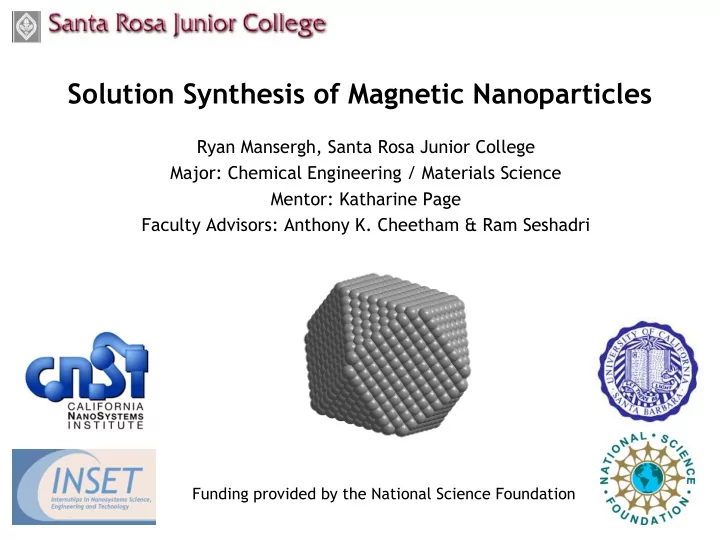

Solution Synthesis of Magnetic Nanoparticles Ryan Mansergh, Santa Rosa Junior College Major: Chemical Engineering / Materials Science Mentor: Katharine Page Faculty Advisors: Anthony K. Cheetham & Ram Seshadri Funding provided by the National Science Foundation
Solution Synthesis of Magnetic Nanoparticles Project Overview: • A project of the Cheetham and Seshadri groups at the Materials Research Laboratory, under the mentorship of Katharine Page. • Research focuses on the synthesis and characterization of magnetic nanoparticles. • At a fundamental level, the research examines how the size of nanoparticles affects their properties. • A number of potential applications for magnetic nanoparticles exist, such as those in medical imaging, data storage, and catalysis. Synthesis occurs at relatively low temperatures in solution, thus allowing a highly scalable method of production. • Funding provided through the following NSF programs: The Chemical Bonding Center, Graduate Student Fellowship, and the Faculty Career Award.
Solution Synthesis of Magnetic Nanoparticles • We are currently looking at what parameters affect the size and morphology of the synthesized nanoparticles. Some of the parameters include the reaction time, reaction temperature, and the type of capping agent used. • Many metals, including nickel, are most stable in the face-centered cubic (fcc) phase. One of the systems we are working with, cobalt oxide, is most stable in the rock-salt phase. • Powder X-ray diffraction (XRD) is the principle means of characterization. A superconducting quantum interference device (SQUID) magnetometer will be used for collecting magnetic data, and electron microscopy will be used for imaging. • Our group has previously prepared wurtzite cobalt oxide. Further effort will be directed at preparing additional energetically trapped, meta-stable materials, such as hexagonally close-packed nickel.
Solution Synthesis of Magnetic Nanoparticles • A glovebox is used for handling the starting materials. 1) The precursor consists of 1 g (3.9 mmol) of cobalt(II) acetylacetonate OR Ni(acac) 2 , added to a three-necked flask. 2) For the solvent, 40 mL (210 mmol) of dibenzyl ether is added. • The solution is then allowed to reflux for a specific amount of time. • Next, the nanoparticles are washed several times in ethanol. • Upon drying, the sample is then ground using a mortar and pestle for later characterization.
Solution Synthesis of Magnetic Nanoparticles Powder X-Ray Diffraction Data for Ni Nanoparticles Refluxed under nitrogen for 1 hr at 270ºC A particle size of ~30 nm was calculated via Scherrer broadening hcp Ni: P6 3 /mmc fcc Ni: Fm-3m We are forming both the fcc and hcp Ni phase with our solution synthesis.
Solution Synthesis of Magnetic Nanoparticles Effect of Reflux Time on Morphology for Ni Nanoparticles Refluxed under nitrogen at ~270ºC The broadening of the peaks and the relative phase amounts are not affected by reflux time.
Solution Synthesis of Magnetic Nanoparticles Powder X-Ray Diffraction Data for CoO Nanoparticles Refluxed under nitrogen for 1 hr at 273ºC (with capping agent) rock-salt CoO A particle size of ~10 nm was calculated via Scherrer broadening These experimental parameters allow us to prepare clean, rock-salt phase CoO nanoparticles.
Solution Synthesis of Magnetic Nanoparticles Powder X-Ray Diffraction Data for CoO Nanoparticles Refluxed under nitrogen for 1 hr at 271ºC (without capping agent) wurtzite CoO A particle size of ~10 nm was calculated via Scherrer broadening We can selectively form CoO nanoparticles in either the rock-salt or wurtzite modification by introducing a capping agent during the reflux.
Solution Synthesis of Magnetic Nanoparticles Future Plans • Samples will be taken to a synchrotron x-ray source for further characterization. • Novel diffraction techniques will be explored. • Transmission electron microscopy (TEM) will allow us to compare the actual sizes of the Katharine Page nanoparticles to our calculated values. Katharine Page
Solution Synthesis of Magnetic Nanoparticles Acknowledgements • Funding provided through the following NSF programs: Chemical Bonding Center Graduate Student Fellowship Faculty Career Award • The Internships in Nanosystems, Science, Engineering, & Technology (INSET) Program, sponsored by the California NanoSystems Institute (CNSI). • The University of California, Santa Barbara and the staff of the Materials Research Laboratory (MRL). And… a big thanks goes to the Cheetham and Seshadri Groups, and my mentor, Katharine Page!
Recommend
More recommend